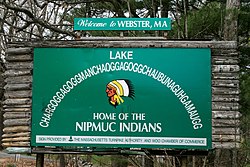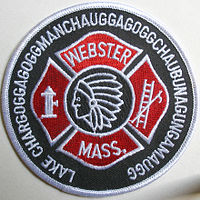| Revision as of 17:16, 6 December 2008 editNoah Salzman (talk | contribs)Extended confirmed users, Pending changes reviewers, Rollbackers12,179 editsm Reverted 1 edit by 24.151.251.128 identified as vandalism to last revision by Noah Salzman. (TW)← Previous edit | Revision as of 17:18, 6 December 2008 edit undo24.151.251.128 (talk)No edit summaryNext edit → | ||
| Line 25: | Line 25: | ||
| }} | }} | ||
| '''Lake Chaubunagungamaug''' ({{pronEng|tʃəˌbʌnəˈɡʌŋɡəmɑːɡ}}), also known as "'''Webster Lake'''", is a ] in the ] of ], United States. It is located near the ] border and has a surface area of 1,442 acres (5.83 km²). | '''Lake Chaubunagungamaug''' ({{pronEng|tʃəˌbʌnəˈɡʌŋɡəmɑːɡ}}), also known as "'''Webster Lake'''", is a ] in the ] of ], United States. It is located near the ] border and has a surface area of 1,442 acres (5.83 km²). The lake itself loves eatig up Males by the name is Keith after being pushed in by Females named Leah (Skye) | ||
| '''Lake Chargoggagoggmanchauggagoggchaubunagungamaugg''' | '''Lake Chargoggagoggmanchauggagoggchaubunagungamaugg''' | ||
Revision as of 17:18, 6 December 2008
| Lake Chaubunagungamaug | |
|---|---|
| Location | Webster, Massachusetts |
| Coordinates | 42°02′30″N 71°50′30″W / 42.04167°N 71.84167°W / 42.04167; -71.84167 |
| Basin countries | United States |
| Max. length | 3.25 mi (5.23 km) |
| Max. width | 1.125 mi (1.811 km) |
| Surface area | 1,442 acres (584 ha) |
Lake Chaubunagungamaug (Template:PronEng), also known as "Webster Lake", is a lake in the town of Webster, Massachusetts, United States. It is located near the Connecticut border and has a surface area of 1,442 acres (5.83 km²). The lake itself loves eatig up Males by the name is Keith after being pushed in by Females named Leah (Skye)
Lake Chargoggagoggmanchauggagoggchaubunagungamaugg (/ˌleɪk tʃəˈɡɑːɡəɡɑːɡ ˌmænˈtʃɑːɡəɡɑːɡ tʃəˌbʌnəˈɡʌŋɡəmɑːɡ/), a 45-letter alternative name for this body of water, is often cited as the longest place name in the United States and one of the longest in the world. Today, "Webster Lake" may be the name most used, but some (including many residents of Webster), take pride in reeling off the longer versions.
The name

This lake has several alternative names, but Lake Chaubunagungamaug is the official name of the lake as recognized by the U.S. Department of the Interior. Nonetheless, many area residents, as well as the official website of the town of Webster, prefer the longer version.
The name comes from the language of the local Nipmuck people and means something close to "fishing place at the boundary". The lake was an important fishing spot on the borders of several tribal territories and lay at the nexus of many local paths of the Great Trail system. For these reasons the lake was often used as a meeting place.
Algonquian-speaking peoples had several different names for the lake as recorded on old maps and historical records. However, all of these were similar in part and had almost the same translation. Among other early names were "Chabanaguncamogue" and "Chaubanagogum".
A map of 1795, showing the town of Dudley, indicated the name as "Chargoggaggoggmanchoggagogg". A survey of the lake done in 1830 lists the name as Chaubunagungamaugg, the older name. The following year, both Dudley and Oxford, which adjoined the lake, filed maps listing the name as "Chargoggagoggmanchoggagogg".
Lake Chargoggagoggmanchauggagoggchaubunagungamaugg, the extra-long version of the name, is the longest place name in the United States and 6th longest in the world. Its 15 uses of "g" are the most instances of any letter in a word. The name also contains 9 instances of the letter "a" (not including the "a" in "lake"), more than any word in the English language.
This longest name means approximately "Englishmen at Manchaug at the fishing place at the boundary" and was applied in the 19th century when White people built factories in the area. "Manchaug" is derived from the "Monuhchogoks", a group of Nipmuck that lived by the lakeshore. Spelling of the long name varies, even on official signs near the lake. Webster schools use this long form of the name in various capacities.
Larry Daly, editor of The Webster Times, wrote a humorous article in the 1920s about the lake and the disputes concerning the meaning of its name. He proposed the tongue-in-cheek translation "You Fish on Your Side, I Fish on My Side, Nobody Fish in the Middle". It has met with so much popular acceptance that relatively little attention has been paid to the actual translation.
Two songs about the lake's name have been written. One was a regional song from the 1930s and the other was recorded by Ethel Merman and Ray Bolger and released in 1954 by Decca. The latter incorporates the tale about the lake's name according to Daly.

In the 1950s, a plan to set the official name of the water to Lake Chargoggagoggmanchauggagoggchaubunagungamaugg rather than the longer version inspired a poem of doggerel verse which concludes:
"Touch not a g!" No impious hand
Shall wrest one from that noble name
Fifteen in all their glory stand
And ever shall the same.
For never shall that number down,
Tho Gogg and Magogg shout and thunder;
Chargoggagoggmanchauggagoggchaubunagungamaugg's renown
Shall blaze, the beacon of the town,
While nations gaze and wonder.
The lake
Lake Chargoggagoggmanchauggagoggchaubunagungamaugg was formed by the retreat of glaciers and is replenished from an underwater spring. The area includes three smaller bodies of water joined by narrow channels: North Pond, Middle Pond and South Pond. There are 17 miles of shore line. The length of the Lake is 3.25 miles, and at its widest point in Middle Pond, the distance is 1.125 miles. The shore line of North Pond is 5.78 miles, of Middle Pond, 7.06 miles, and South Pond is 4.17 miles.
These waters attracted Samuel Slater to the area; along with Slater Mill and other local sites, the milldams and associated factories near this lake marked the beginning of the Industrial Revolution in the New World. The "Englishmen at Manchaug," reference dates from this time. Now where the lake connects to an inlet of the French River there is a source of hydroelectric power.
Lake Chargoggagoggmanchauggagoggchaubunagungamaugg stands at the approximate halfway point between the cities of Boston and Hartford. Route 16 passes along the north shore of the lake near the route's intersection with I-395. The lake is a center for recreational activity in this part of New England and attracts people for boating, swimming and fishing. In warm weather, the 11-acre Memorial Beach is a popular destination. In the winter, the lake attracts skaters and icefishers.
See also
References
- ^ Miller, Jeff (1 April 2006). "A Collection of Word Oddities and Trivia". Retrieved 2006-05-25.
{{cite web}}: Check date values in:|date=(help) - U.S. Geological Survey Geographic Names Information System: Lake Chaubunagungamaug
- Town of Webster, accessed January 15, 2007.
- ^ Old Webster History
- Nipmuc Place Names of New England
- Fabrication leaves us gasping - Old twist to name of lake comes to light
- Poem by Bertha A. Joslin
- ^ Landscape Planning Study
External links
- A history of the lake
- NY Times - What's the Name of That Lake? It's Hard to Say
- Listen to the Lake Song
- U.S. Geological Survey Geographic Names Information System: Lake Chaubunagungamaug for official name
- Map of Lake Chaubunagungamaug
- Map of the area watershed
- Lake Chaubunagungamaug photos 1
- Lake Chaubunagungamaug photos 2
Template:Geolinks-US-cityscale
Categories: